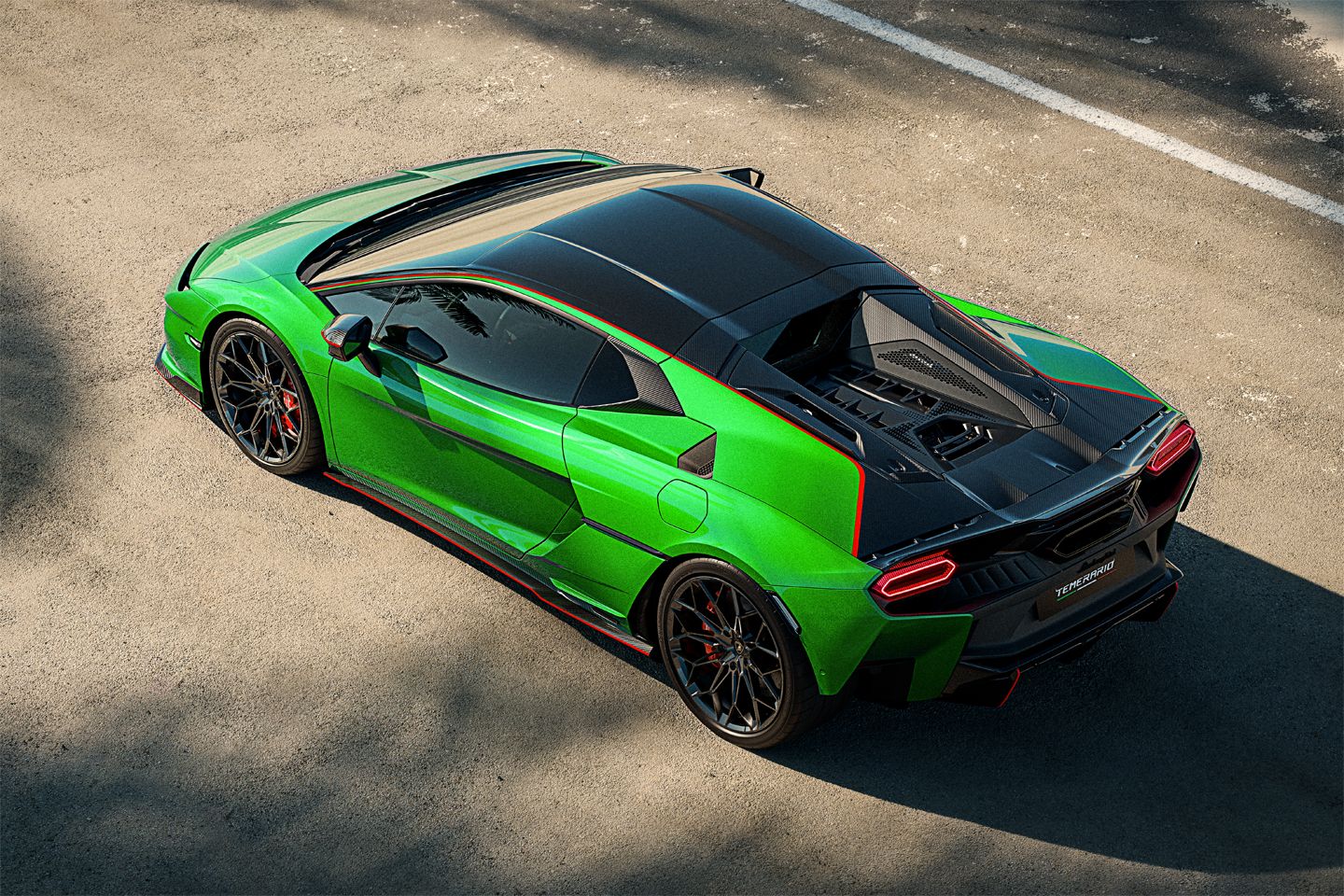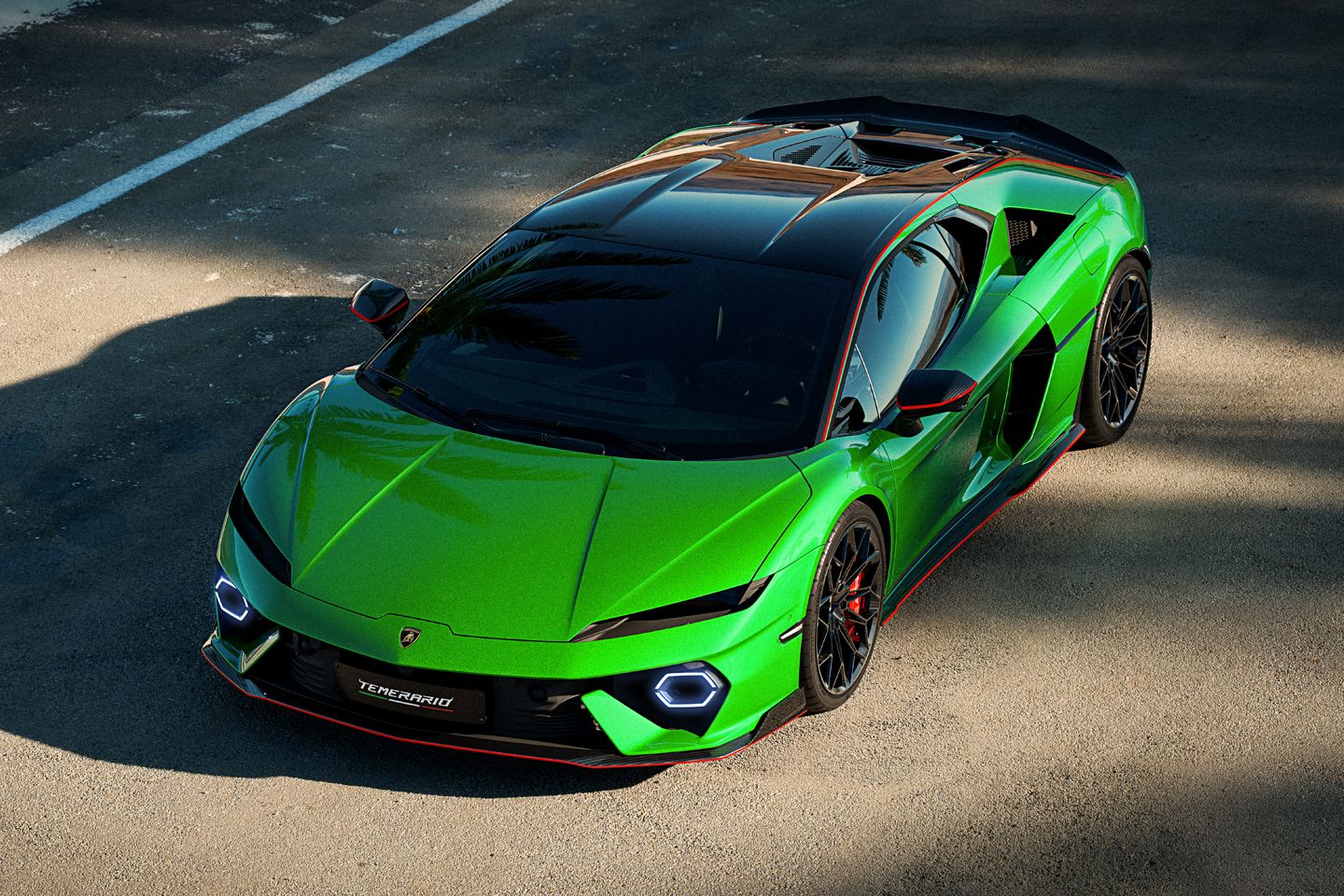The Huracan was always going to be a difficult car to replace. By the end of its life, the dream team of epic V10, stunning design and well-sorted chassis had made it one of the supercar greats. This is how Lamborghini will follow it up: the 920hp, 10,000rpm, plug-in hybrid, four-wheel drive Temerario. Nothing less than a ‘new super sports car in a league of its own’, according to Sant’Agata.
It marks a huge step change for the ‘junior’ Lamborghini (as well as completing the hybrid lineup alongside the Revuelto and Urus SE). For 20 years the model beneath the V12 flagship had a V10 that went from 5.0-litre to 5.2 from Gallardo to Huracan. Even when the Aventador became the Revuelto, a 6.5-litre V12 remained. So this really is a very different beast from anything we’ve seen from Lamborghini before, not least in terms of sheer power: the Gallardo launched with 500hp, and the Huracan 610hp. This Temerario goes to market with 920hp.
That power comes courtesy of an all-new 3,995cc, twin-turbo, dry-sumped ‘hot-V’ V8 called L411, which makes 800hp all on its own at a brain-scrambling 9,000rpm. It remains till 9,750rpm, with the limiter at 10. A 10,000rpm, series production, V8 Lamborghini. Even with that information known prior to Monterey Car Week, it seems almost unbelievable. The engine also makes 538lb ft by itself, and you wouldn’t be alone in thinking an 800hp, 538lb ft, 10,000rpm V8 might make a nice understudy to the 1,015hp Revuelto just as is. But then it wouldn’t be a Lamborghini High Performance Electric Vehicle. It is thanks to a 3.8kWh battery pack and a trio of electric motors (one in the P1 position between engine and gearbox, two on the front axle), that maximum power for the Temerario is rated at 920hp. Lamborghini says it’ll reach 62mph in just 2.7 seconds, and more than 210mph flat out; a Diamond Like Carbon (DLC) covering for the cam finger followers can withstand up to 11,000rpm, and the fuel is injected at 350bar. It’s all fairly bonkers.


The eight-speed DCT for Temerario is new, said to be lighter and faster than the old Huracan seven-speed. It sits transversely behind the engine so that there’s space for the battery back in the conventional transmission tunnel area. As with the Revuelto, the electrification of the Temerario is very much to boost performance and cut CO2 (by 50 per cent over the V10, reckons Lambo) than offer meaningful EV range. Expect a few kilometres of silent running in Citta mode, with up to 7kW of charging rate possible. Or the engine can be run in recharge mode to replenish the cells, which seems to defeat the object a little – but the option is there.
When not running in electric mode, the Temerario promises a thrilling new soundscape. Lamborghini says it has invested ‘significant technical effort in the development of a unique and unmistakable audio experience from the Temerario’s completely new drive system’. So they’ve thought about how the exhaust is routed from manifold to tailpipe, how the engine mounts are designed, how the vibrations of the flat-plane crank layout can be emphasised. There’s even – shock, horror – a sound symposer for inside. Apparently an ‘exhilarating and powerful listening experience’ awaits in Sport and Corsa modes.
The Temerario is underpinned by all-new architecture – no longer any commonality with any Audi whatsoever. Made from ultra-light alloy, it promises 20 per cent improved torsional rigidity compared to a Huracan (which will be handy for a Spyder) as well as improved interior space. Dry weight is claimed to be 1,690kg for the 4.7m-long Temerario, so it’s not exactly slender, though the Revuelto has to some extent addressed a lot of concerns about heavy Lambos not being anything less than epic.


This will feature much of the same tech that helped the V12 boggle so many minds, the e-axle meaning that the second generation of the Lamborghini Dinamica Veicolo features in the Temerario. This means proper torque vectoring, with brakes only employed when absolutely necessary, a Drift Mode for ‘controlled oversteer’ and, er, 13 different ‘driving experiences’. Don’t worry, it’s mainly an extension of the drive modes, though rest assured there’ll be plenty to fiddle with – a Corsa Plus mode, Launch control, three settings for the hybrid and so on. As with the Revuelto, Sport will be the fun setting and Corsa is there for lap times. CTO Reuven Mohr makes the Temerario sound even more exciting than the naked stats do: “Temerario offers an innovative and emotional driving experience at the same time. The e-4WD system including real torque vectoring is a perfect combination. On the one hand we have a car that is absolutely precise and effective on the track, on the other we have a more typically rear-wheel drive character, oriented towards maximum involvement for the driver.” With 920hp, and 10,000rpm.
Those with track driving in mind will be pleased to know that an ‘Alleggerita’ package will be available from launch, along with the option of Bridgestone Potenza Sport Race tyres (as used on the old STO) for the 20-/21-inch wheels. The lightweight pack introduces a lot of CFRP for outside, including for the bonnet, side skirts and some underbody panels. Fixed polycarbonate side windows save 450g – it’s pretty serious alright. Note as well the carbon wheels, which aren’t part of the pack but are on the extras list with a titanium exhaust. Lambo says that an Alleggerita with all the associated lightweight goodies saves more than 25kg and is even more aerodynamically efficient. Probably not essential, then, but great for pitlane kudos. And showing up 296 Assetto Fioranos.
Speaking of aero, Lamborghini claims better than double the rear downforce of a Huracan Evo for a Temerario (+103 per cent). Three design goals were set out from the beginning: increased cooling, stability at high speed and brake efficiency. Seemingly everything now contributes to aerodynamic performance, from the daytime running lights (which send air from the bumper to the side radiators) to the wing mirrors (drag optimised) to the roof, with its central channel that assists efficiency and downforce. As is so often the case, too, underneath plays a huge part, the Temerario’s vortex generators much larger than before. Cooling performance has been improved by 30 per cent (because a twin-turbo V8 hybrid needs a lot more than a nat-asp V10), with cooling of the brake discs said to be better by 20 per cent also.


Lamborghini says that the Temerario interior has been designed to make the driver ‘feel like a pilot’ when they’re behind the wheel thanks to the low seat, slim dash and inclination of the steering wheel. From here it looks a lot like they’ll be piloting a Revuelto – probably no bad thing – though it does mean both models look quite similar. Of just as significant to anyone thinking of swapping their Huracan (and their numb bum) for a Temerario is the introduction of a ‘newly-developed comfort seat’; now 18-way adjustable, it must be a comfier pew than what came before. Carbon shell buckets are there for those who want something racier. The promise is of 34mm more headroom, 46mm more legroom and better visibility; Lambo reckons ‘even the tallest drivers’ can wear a helmet comfortably for track work, which feels as big a deal as comfy seats. The infotainment screen is an 8.4-inch portrait display, the driver’s dash is 12.3 inches across, the front passenger display is 9.1-inch unit and the boot capacity is… 112 litres. Or two cabin trolleys, apparently. With nominal space behind the seats, too. A very modern Lambo in some senses then, with a few old-school quirks alongside.
Stephan Winkelmann said: “The Temerario is a genuine ‘fuoriclasse’: a car in a league of its own, an extraordinary and innovative vehicle both from a technical and stylistic point of view. Every new Lamborghini must surpass its forerunners in performance terms, while at the same time being more sustainable from an emissions standpoint. With the Temerario, we have completed a key chapter in the electrification strategy included in our Direzione Cor Tauri plan: we also become the first luxury automotive brand to offer a completely hybridized range.” We’ve no steer on cost yet, though given the huge uptick in performance over a Huracan, a price rise seems likely also. If a Revuelto is a £400,000 car, it’s easy to imagine this being a £300,000 one. With more than 400 colours to choose from, of course – time to get busy on the configurator now, with first deliveries expected in 2025.

